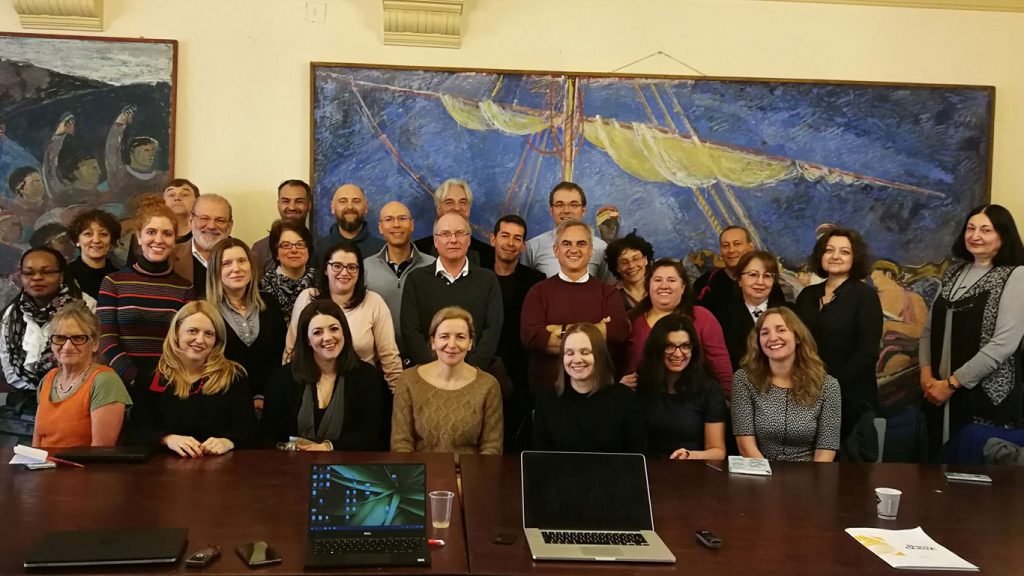Understanding rare neurodevelopmental disorders (NDD) has the potential drive major new therapies for the common NDD of schizophrenia and Autism Spectrum Disorder (ASD).

NDD affect 1 in 25 individuals in Europe and have high impact on healthcare systems, economic development and society. Our key challenge is to link new knowledge from psychiatric genomics to identify neurobiological mechanisms that lead to NDD.
Join The Action
The inclusion of further partners from currently participating COST Countries, or other countries within or outside the COST Network, is welcome and strongly encouraged during the entire duration of the Action.
Background
MINDDS focuses on NDD patients with rare pathogenic CNV, whose study have the potential to drive major new understanding and better therapies for all NDD, including the more common neuropsychiatric disorders of Autism Spectrum Disorder (ASD) and schizophrenia. Currently, lack of mechanistic knowledge hampers development of improved patient diagnosis and treatment.
Mental wellbeing is an important contributor to health and prosperity of all European citizens. Neurodevelopmental disorders (NDD) are a major class of mental health conditions, and arise when disruption of brain development leads to neuropsychiatric impairments of learning, memory, executive function, emotion and social interaction. They affect approximately 18 million European citizens per year, nearly 4% of the population. Their effects arise during childhood, adolescence, or early adulthood, but are usually life-long.
NDD span the overlapping triad of childhood-onset disorders, Autism Spectrum Disorder (ASD), developmental delay (DD) and intellectual disability (ID), but also include schizophrenia, the onset of which peaks in late adolescence to early adulthood. On close inspection there are many clinical symptoms that overlap between the different categories of NDD, suggesting common biological mechanisms. For example, 22q11.2 Deletion Syndrome (22q11.2DS) is associated with mild to moderate intellectual disability (60%), whilst 55% of cases have at least one psychiatric diagnosis, including ADHD (41%) and ASD (26%).
Furthermore, comorbidity is seen between NDD and apparently unrelated, non-psychiatric conditions such as epilepsy and cardiac malformation, indicating a broader biology than previously suspected. Together these overlaps can make diagnosis difficult, and argues for improved criteria for clinical assessment.
At present, current therapies, when available, are at best palliative, treating symptoms not fundamental pathophysiological causes. Consequently, the persistence and severity of NDD impart a disproportionally large burden on European healthcare services, with a high socio-economic impact (estimated as ~€180 Billion per year). To meet this challenge, it is essential to identify the pathophysiological mechanisms that lead to NDD, as these provide the route to effective therapeutic strategies, accurate diagnosis and improved patient benefit.
Major advances in genomics have now identified several hundred genes, whose mutations contribute to increased risk for NDD. Consistent with clinical observations, many of these genes overlap the different NDD. Unfortunately, the genetics of NDD is complex and the current picture is incomplete. It is clear for ASD and schizophrenia that genetic risk for most people is due to the accumulation of many genes, each of weak effect. There is also considerable clinical variation for all of the major NDD, so that for almost all individuals the effects of similar genetic risk loads differ in their psychiatric symptoms and their severity. This makes direct correlation between specific gene mutations and patient symptoms very difficult.
Some rare patients carry much stronger, genetically penetrant, risk mutations due to major deletions or duplications of regions of their chromosomes (pathogenic Copy Number Variants; CNV). These offer a unique opportunity to investigate the relationship between genetic risk and the biology of NDD. MINDDS aims to maximize research impact of the study of these rare NDD patients to gain better understanding, improved diagnosis and new treatments.
Objectives
MINDDS aims to substantially accelerate NDD research progress via a Europe-wide collaborative network to identify individuals who possess pathogenic CNV, agree standardized assessments and research protocols and facilitate data sharing and knowledge exchange for the benefit of researchers, clinicians and patients.

MINDDS will achieve its objectives by:
- Design and develop of an approach for transnational patient recruitment, incorporating regulatory, legal and ethical requirements. These will include protocols for new clinical assessment, patient registration and data deposition.
- Standardization of protocols and methodologies to maximize the utility
and quality of the resultant research data outputs. Standardized research protocols will encompass the major study regimes, including clinical phenotyping, brain imaging and patient-derived cell studies. - Delivery of data integration and sharing via linkage to relevant data platforms, supporting informatics protocols to enhance NDD patient research.
- Place the study of rare NDD patients in the context of other neuroscience research by promoting a Convergent Neuroscience approach.
- An education programme for enhanced training and knowledge exchange including research conferences, training schools and workshops.
- Creation of standardized protocols, experimental methodologies and best practice for NDD research.
- Knowledge exchange via its “Knowledge Nexus” to collate and share our expanding knowledge with researchers, clinicians and patients.
Scientific Programme
MINDDS is a pan-European partnership between researchers, clinicians and patient organizations to facilitate research on NDD associated with pathogenic CNV. It will focus on the development of improved patient identification and assessment, standardization of research protocols and guidelines and methodologies for data deposition, sharing and analysis.
WG1: Patient Cohort Framework
Rare NDD patients who carry pathogenic CNVs present both a clinical challenge and a research opportunity. Improved patient identification will serve the dual purpose of improving patient healthcare and facilitate new research. To achieve this, it is necessary to establish a common framework for genetic and clinical assessment and cohort building.
WG1 aims to facilitate patient cohort building of a size not previously possible by proposing common procedures for all participating centers. We will develop gold standard assessment criteria to ensure uniform patient selection across all sites. An effective means will be agreed for patient registration with full consent and in accordance with an ethical and legal framework, including longitudinal follow-up and obtaining of biological samples, including for genotyping, gene expression and induced pluripotent stem cells (iPSC) generation. This will be supported by continued communication with patients and making research findings available to participants.
WG2: Clinical Phenotyping
To maximize research value of our patient cohorts with rare CNV, it is essential to ensure uniformity of protocols for NDD clinical research and patient phenotyping.
WG2 will review current methodologies and survey common practice across COST participating countries and international partners. Based on the outcome, we will establish standardized clinical phenotyping protocols, and propose guidelines for best practice Genetic knowledge indicate that assessments should incorporate objective measures such as neurocognitive testing, motor function, and brain imaging.
WG3: Emerging Technologies
New technologies, such as patient derived stem cells, direct cell reprogramming and genome-wide sequencing technologies offer huge potential for detailed patient studies. As these mostly reside in the preclinical research arena, there is a need for careful translation to the clinical context. We will consider how best to utilize emerging technologies for patient to the clinical level for patient-based studies.
WG3 will review new and recent advances in cell-based technologies and propose standardized protocols for cell re-reprogramming and neuro-differentiation, including criteria for quality control, quantification and data encoding. Similar consideration will be undertaken for cell and patient phenotyping based genomic applications. Finally, we will maintain a watching brief of new technology and assays as they become available.
WG4: Databases and informatics
A key objective of MINDDS is to consider how NDD patient data can be captured and integrated with common, discoverable databases, ensuring that it is available for data sharing and health informatics.
WG4 will seek optimal approaches for data capture, integration and sharing. We will address the three-fold needs of (i) supporting research and health informatics projects; (ii) access to a patient registry for NDD; and (iii) a web-based knowledge exchange “nexus”. To avoid variation due regional differences, such as language, culture and local healthcare provision, common data elements will be proposed to ensure interoperability and harmonization of phenotype data.
Infrastructural requirements, such as data storage capacity, security and procedures for data sharing compliant with ethical and regulatory requirements will be considered and recommendations made for the benefit of future projects.
WG5: Integration and Convergence
To be effective the objectives of MINDDS need to integrate across all of the network’s activities and partners, and converge with wider basic, preclinical and clinical neuroscience research. By ensuring integration and convergence, the knowledge gained from studying rare CNVs may drive understanding for all neuropsychiatric disorders.
WG5 will maximize integrate across different CNVs, clinical phenotypes and alternative experimental and analytical modalities to create the route to a conceptual framework and predictive computational model that extends across genomic, cell and patient data. Our integrated outputs will be configured to ensure convergence with other research strategies, such as animal and cell-based models, and epigenomic, transcriptomic and cellomic techniques. In a reverse process, we will recommend experimental guidelines to maximize the compatibility of preclinical models for understanding patient biology.
Further, WG5 will direct our communication strategy to ensure effective knowledge exchange between all of MINDDS participants, partners and stakeholders

